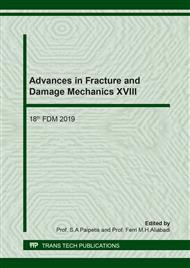[1]
De Luca, A., Caputo, F., Sharif Khodaei, Z., Aliabadi, M.H. Damage characterization of composite plates under low velocity impact using ultrasonic guided waves. (2018) Composites Part B: Engineering, 138, pp.168-180.
DOI: 10.1016/j.compositesb.2017.11.042
Google Scholar
[2]
Sepe, R., De Luca, A., Lamanna, G., Caputo, F. Numerical and experimental investigation of residual strength of a LVI damaged CFRP omega stiffened panel with a cut-out. (2016) Composites Part B: Engineering, 102, pp.38-56.
DOI: 10.1016/j.compositesb.2016.07.009
Google Scholar
[3]
Tamuzs, V., Tarasovs, S., Vilks, U. Delamination properties of translaminar-reinforced composites. (2003) Composites Science and Technology, 63 (10), pp.1423-1431.
DOI: 10.1016/s0266-3538(03)00042-3
Google Scholar
[4]
Johnsen, B.B., Kinloch, A.J., Mohammed, R.D., Taylor, A.C., Sprenger, S. Toughening mechanisms of nanoparticle-modified epoxy polymers. (2007) Polymer, 48 (2), pp.530-541.
DOI: 10.1016/j.polymer.2006.11.038
Google Scholar
[5]
Hsieh, T.H., Kinloch, A.J., Masania, K., Taylor, A.C., Sprenger, S. The mechanisms and mechanics of the toughening of epoxy polymers modified with silica nanoparticles. (2010) Polymer, 51 (26), pp.6284-6294.
DOI: 10.1016/j.polymer.2010.10.048
Google Scholar
[6]
Deng, S., Ye, L., Friedrich, K. Fracture behaviours of epoxy nanocomposites with nano-silica at low and elevated temperatures. (2007) Journal of Materials Science, 42 (8), pp.2766-2774.
DOI: 10.1007/s10853-006-1420-x
Google Scholar
[7]
Bernd Wetzel, Patrick Rosso, Frank Haupert, Klaus Friedrich. Epoxy nanocomposites – fracture and toughening mechanisms. (2006) Engineering Fracture Mechanics, 73(16), pp.2375-2398.
DOI: 10.1016/j.engfracmech.2006.05.018
Google Scholar
[8]
Quaresimin, M., Salviato, M., Zappalorto, M. A multi-scale and multi-mechanism approach for the fracture toughness assessment of polymer nanocomposites. (2014) Composites Science and Technology, 91, pp.16-21.
DOI: 10.1016/j.compscitech.2013.11.015
Google Scholar
[9]
Odegard, G.M., Clancy, T.C., Gates, T.S. Modeling of the mechanical properties of nanoparticle/polymer composites. (2005) Polymer, 46 (2), pp.553-562.
DOI: 10.1016/j.polymer.2004.11.022
Google Scholar
[10]
Hamdia, K.M., Zhuang, X., He, P., Rabczuk, T. Fracture toughness of polymeric particle nanocomposites: Evaluation of models performance using Bayesian method. (2016) Composites Science and Technology, 126, pp.122-129.
DOI: 10.1016/j.compscitech.2016.02.012
Google Scholar
[11]
Riccio, A., Russo, A., Raimondo, A., Sellitto, A. Numerical investigation on delamination growth in composite panels including fibre-bridging effect. (2018). Aerotecnica missili & spazio, 97(1), pp.34-39.
DOI: 10.1007/bf03404763
Google Scholar
[12]
Riccio, A., Russo, A., Sellitto, A., Raimondo, A. Development and application of a numerical procedure for the simulation of the Fibre Bridging, phenomenon in composite structures. (2017) Composite Structures, 168, pp.104-119.
DOI: 10.1016/j.compstruct.2017.02.037
Google Scholar
[13]
Krueger, R. Virtual crack closure technique: History, approach, and applications. (2004) Applied Mechanics Reviews, 57 (1-6), pp.109-143.
DOI: 10.1115/1.1595677
Google Scholar


